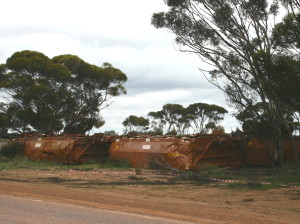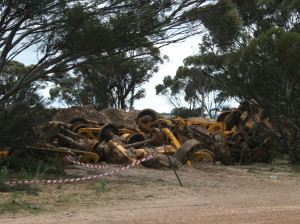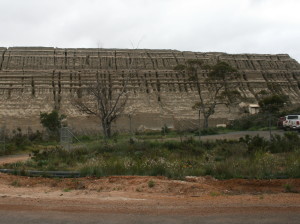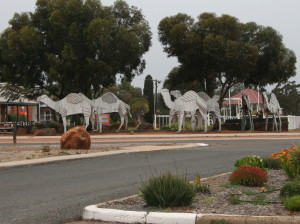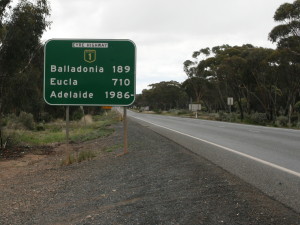It has occurred to me that I may well encounter some Internet black-spots as I cross the Nullarbor. Australia is quaint in that it can invent the ‘Black Box’ flight recorder, but can’t keep its population/landmass covered with mobile phone or Internet. I have to put up with this, I know I do, but it doesn’t make it any more acceptable in the 21st Century. So if you don’t see any posts it’s unlikely I’ll have been eaten by a monster or abducted by Martians. More than likely I’ll be in the frustrating situation of having no Internet connection.
Shinglebacks! These cute stumpy-tailed lizards are all over the place, playing a sort of reptile game of chicken on the roads. I think the sure footed Camel managed to miss them all.
Fuel has become an issue. Not so much the availability as the quality. On a diet of 91 octane Camel’s best at cruising speed of 110 km/hr has been 8.8 − 8.6 l/100 kms, though reducing speed to 100 km/hr improves the fuel consumption to 8.4. When the gauge shows one-third has been consumed, I have been in the habit of topping up with 95 octane, which immediately gives a figure of 7.8 l/100 kms. Currently, with a second topping up of just ten litres of 98 octane, the figure returned is 7.2. I rest my case for the higher octane… but no way is Camel getting a full tank of such rich juice at $2.19 per litre!
The road from Esperance has been wide and smooth, with very little traffic. For a while I had the pleasure of driving alongside – and pacing – a train of empty wagons, then I noticed the remains of a derailment and stopped to take some photos. There was no sign of cargo, so I imagine the wagons were all empty. Not long after that I met a train coming the other way, its wagons loaded with ore. From what a local in Esperance told me, I guessed it was nickel heading for the port.
I took a detour off the bitumen to see what’s left of the old gold-mining town of Dundas. In 1894 it was a young and vibrant town, with its hotel, blacksmith, school shops and churches, but richer pickings were found in what was to become Norseman, 25 kms north. By the 1920s Dundas was abandoned.
Norseman is a gold-mining town which today produces around 100,000 ounces of gold per annum. Somebody, give me a pick and shovel! As I’ve found in these out-of-the-way little towns in WA, they have their social problems. Despite the beautifully decorated roundabout, with corrugated iron camels and its helpful tourist information centre, it’s hard not to notice the steel shutters on the shop windows or, in the case of the local IGA supermarket, the permanently boarded-up shopfront. Photographs of shoplifters decorate the entrances of these places, too. I wonder if the police or shopkeepers ever catch up with them?
All the distances seem enormous but, on reflection, they’re only kilometres after all.
The carcass of a camel lay rotting on the side of the road on the way into Balladonia. I hope it was a big truck with a bullbar that hit it. A car would be a write-off.

